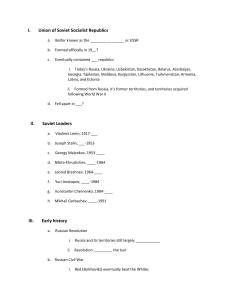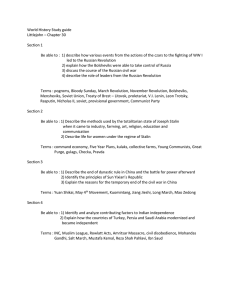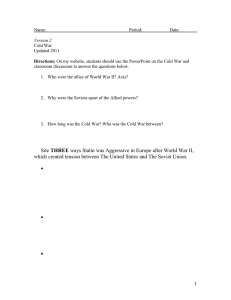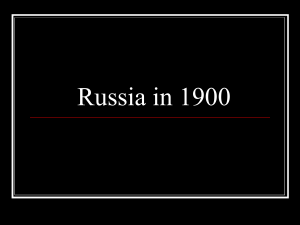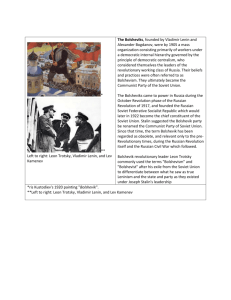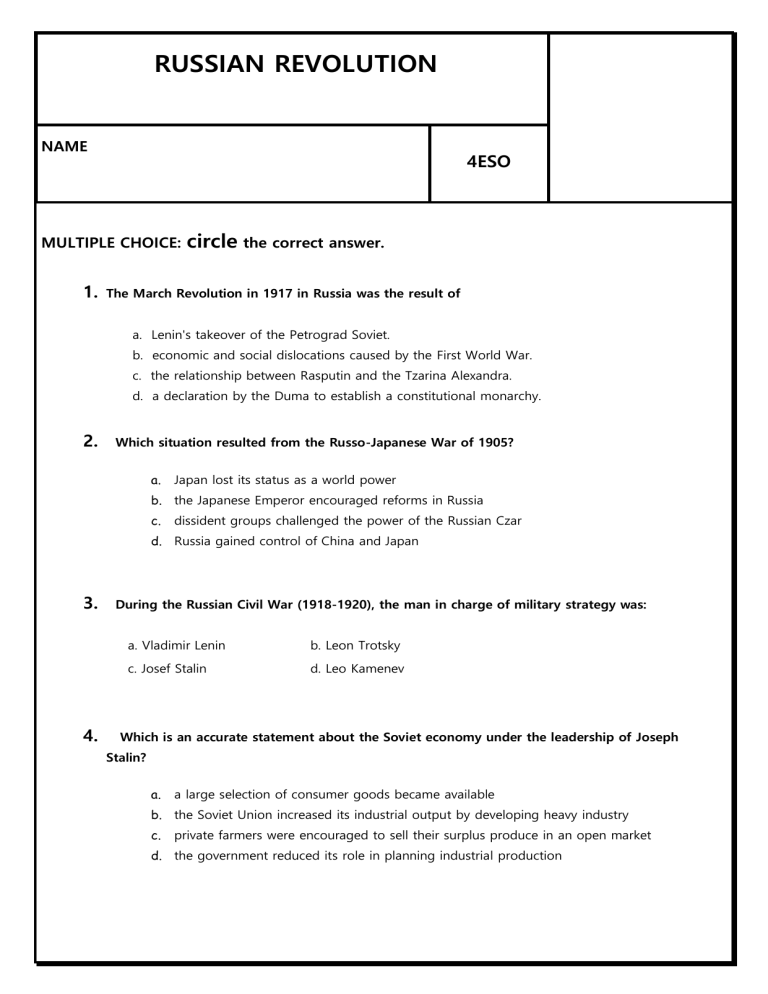
RUSSIAN REVOLUTION NAME 4ESO MULTIPLE CHOICE: 1. circle the correct answer. The March Revolution in 1917 in Russia was the result of a. Lenin's takeover of the Petrograd Soviet. b. economic and social dislocations caused by the First World War. c. the relationship between Rasputin and the Tzarina Alexandra. d. a declaration by the Duma to establish a constitutional monarchy. 2. Which situation resulted from the Russo-Japanese War of 1905? a. Japan lost its status as a world power b. the Japanese Emperor encouraged reforms in Russia c. dissident groups challenged the power of the Russian Czar d. Russia gained control of China and Japan 3. 4. During the Russian Civil War (1918-1920), the man in charge of military strategy was: a. Vladimir Lenin b. Leon Trotsky c. Josef Stalin d. Leo Kamenev Which is an accurate statement about the Soviet economy under the leadership of Joseph Stalin? a. a large selection of consumer goods became available b. the Soviet Union increased its industrial output by developing heavy industry c. private farmers were encouraged to sell their surplus produce in an open market d. the government reduced its role in planning industrial production 5. During the Russian Civil War, 1918-1921, which of the following did NOT oppose Bolshevik rule? a. Tzarists. b. The middle class. c. Urban workers. 6. d. The Allied Powers of World War I. What does USSR stand for? a. Union of Soviet Socialist Republics b. United Soviet Socialist Republics c. Union of Socialist Soviet Republics d. United Socialist Soviet Republics 7. Stalin supported the industrialization of Russia in the 1920s and early 1930s by a. obtaining loans from the West. b. slaughtering the kulaks. c. collectivizing agriculture to support the First Five-Year Plan. d. seeking international recognition of the Soviet Union. 8. The one group in Russia that called for peace and a social revolution rather than a stronger war effort was the a. Social Revolutionaries. b. Constitutional Democrats. c. Populists. d. Bolsheviks. 9. Stalin’s Five-Year Plans and his decision to form collective farms are examples of a. strategies to modernize the economy of the Soviet Union through forced communism b. a more friendly foreign policy toward China c. methods of dealing with the United States during the Cold War d. programs to westernize, educate, and enlighten the population 10. The organizer of the Red Army who lost the struggle for leadership of the Soviet Union to Stalin after Lenin's death was a. Alexander Kerensky. b. Alexander Nevsky. c. Nikita Krushchev. d. Leon Trotsky. 11. What were the two colors of the armies involved in Russian Civil War? a. Reds and Whites b. Yellows and Blacks c. Reds and Blues d. Blacks and Whites 12. 13. Which political party was responsible for the Russian October Revolution of 1917? a. Soviet b. Bolshevik b. Provisional Government c. Menshevik Who opposed Stalin early in his reign, and was then later exiled and finally murdered in 1940 in Mexico City? 14. a.Trotsky b.Stolypin c. Kirov d. Bukharin In 1917-18 the Russians finally wanted out of World War I. In March 1918 they signed an armistice with Germany. This treaty is known as: a. Treaty of Brest-Litovsk b. German-Soviet Pact c. Treaty of Bialystok d. Treaty of Voroshilov 15. The slogan "Peace, Land and Bread" is most closely associated with a. the Duma liberals. b. Alexander Kerensky's moderates. c. Lenin's Bolsheviks. d. Tsar Nicholas's cabinet. 16. Within the Social Democratic party, in the early 1900s, there were two groups, the Bolsheviks and the: a. Milusheviks c. Mensheviks 17. b. Kadets d. Lensheviks What does NEP stand for? a. New Enterprise Products c. New Economic Proud b. New Economic Policy d. National Economic Policy 18. Who was the 'Mad Monk' that influenced the Tsar's family? a. Rasputin b. Putin c. Prince Lvov d. Raskolnikov 19. What was the Gulag? a. The prison system under Stalin b. The secret information network Stalin used on his opponents c. the rich peasants against the communists d. The title of a book 20. Trotsky and Stalin's interpretations of Marxism differed most significantly in which way? a. Trotsky wanted to extend world revolution while Stalin wanted "to build Socialism in one country." b. Stalin wanted to extend revolution in Western Europe while Trotsky wanted to develop the Soviet Union first. c. Stalin was a Bolshevik; Trotsky was a Menshevik. d. Stalin believed that Russia was too backward to support Communism; Trotsky believed the opposite. 21. In the early years of the Bolshevik regime, until 1929, there was still relative cultural freedom. One famous Russian artist and film maker, who made films about the early 20th century revolutions, was: a. Maiakovski b. Eisenstein c. Tolstoi d. Dostoievski 22. Leningrad is to Sainkt Petersburg as Stalingrad is to… i. Petrograd ii. Volgograd iii. Santiagorod iv. Moscow

